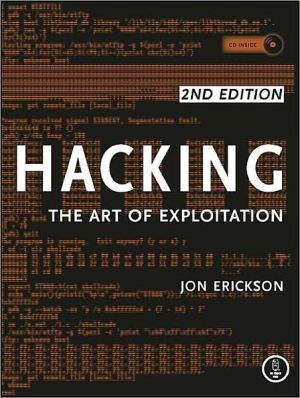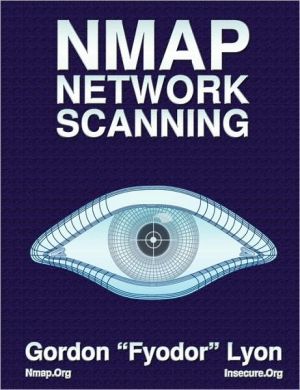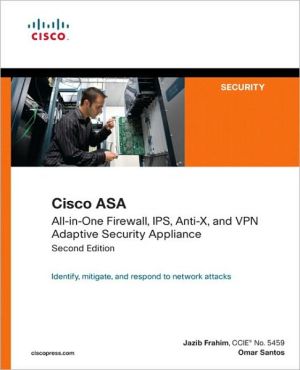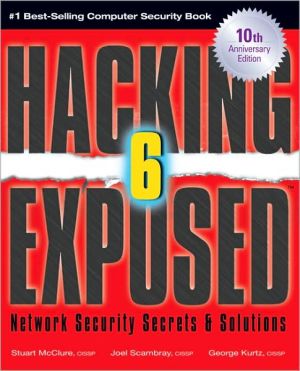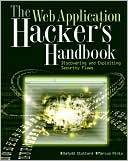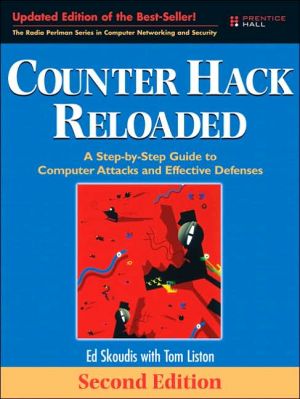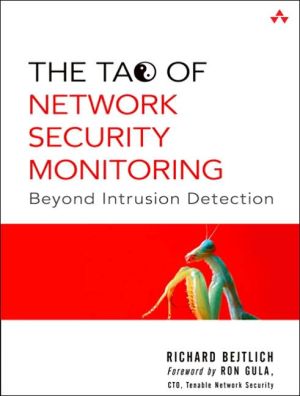Applied Cryptography: Protocols, Algorithms, and Source Code in C
". . .the best introduction to cryptography I've ever seen. . . . The book the National Security Agency wanted never to be published. . . ." -Wired Magazine\ ". . .monumental . . . fascinating . . . comprehensive . . . the definitive work on cryptography for computer programmers . . ." -Dr. Dobb's Journal\ ". . .easily ranks as one of the most authoritative in its field." -PC Magazine\ ". . .the bible of code hackers." -The Millennium Whole Earth Catalog\ This new edition of the cryptography...
Search in google:
". . .the best introduction to cryptography I've ever seen. . . . The book the National Security Agency wanted never to be published. . . ." -Wired Magazine ". . .monumental . . . fascinating . . . comprehensive . . . the definitive work on cryptography for computer programmers . . ." -Dr. Dobb's Journal ". . .easily ranks as one of the most authoritative in its field." -PC Magazine ". . .the bible of code hackers." -The Millennium Whole Earth Catalog This new edition of the cryptography classic provides you with a comprehensive survey of modern cryptography. The book details how programmers and electronic communications professionals can use cryptography-the technique of enciphering and deciphering messages-to maintain the privacy of computer data. It describes dozens of cryptography algorithms, gives practical advice on how to implement them into cryptographic software, and shows how they can be used to solve security problems. Covering the latest developments in practical cryptographic techniques, this new edition shows programmers who design computer applications, networks, and storage systems how they can build security into their software and systems. What's new in the Second Edition? * New information on the Clipper Chip, including ways to defeat the key escrow mechanism * New encryption algorithms, including algorithms from the former Soviet Union and South Africa, and the RC4 stream cipher * The latest protocols for digital signatures, authentication, secure elections, digital cash, and more * More detailed information on key management and cryptographic implementations Booknews "The classic guide to using cryptography to maintain data security, first published in 1994, and an instant best-seller among hackers. It describes dozens of cryptography algorithms, gives practical advice on how to implement them into cryptographic software, and shows how they can be used to solve security problems. This edition covers the latest protocols and algorithms to implement a variety of encryptions. For programmers and electronic communications professionals."-- Annotation c. Book News, Inc., Portland, OR (booknews.com)
\ \ Chapter 8: Key Management\ 8.4 Verifying Keys\ When Bob receives a key, how does he know it came from Alice and not from someone pretending to be Alice? If Alice gives it to him when they are face-to-face, it's easy. If Alice sends her key via a trusted courier, then Bob has to trust the courier. if the key is encrypted with a key-encryption key, then Bob has to trust the fact that only Alice has that key. if Alice uses a digital signature protocol to sign the key, Bob has to trust the public-key database when he verifies that signature. (He also has to trust that Alice has kept her key secure.) If a Key Distribution Center (KDC) signs Alice's public key, Bob has to trust that his copy of the KDC's public key has not been tampered with.\ In the end, someone who controls the entire network around Bob can make him think whatever he likes. Mallory could send an encrypted and signed message purporting to be from Alice. When Bob tried to access the public-key database to verify Alice's signature, Mallory could substitute his own public key. Mallory could invent his own false KDC and exchange the real KDC's public key for his own creation. Bob wouldn't be the wiser.\ Some people have used this argument to claim that public-key cryptography is useless. Since the only way for Alice and Bob to ensure that their keys have not been tampered with is to meet face-to-face, public-key cryptography doesn't enhance security at all.\ This view is naive. It is theoretically true, but reality is far more complicated. Public-key cryptography, used with digital signatures and trusted KDCs, makes it much more difficult to substitute one key for another. Bob can never be absolutely certain that Mallory isn't controlling his entire reality, but Bob can be confident that doing so requires more resources than most real-world Mallorys have access to.\ Bob could also verify Alice's key over the telephone, where he can hear her voice. Voice recognition is a really good authentication scheme. If it's a public key, he can safely recite it in public. If it's a secret key, he can use a one-way hash function to verify the key. Both PGP (see Section 24.12) and the AT&T TSD (see Section 24.18) use this kind of key verification.\ Sometimes, it may not even be important to verify exactly whom a public key belongs to. it may be necessary to verify that it belongs to the same person to whom it belonged last year. If someone sends a signed withdrawal message to a bank, the bank does not have to be concerned with who withdraws the money, only whether it is the same person who deposited the money in the first place.\ Error Detection during Key Transmission\ Sometimes keys get garbled in transmission. Since a garbled key can mean megabytes of undecryptable ciphertext, this is a problem. All keys should be transmitted with some kind of error detection and correction bits. This way errors in transmission can be easily detected and, if required, the key can be resent.\ One of the most widely used methods is to encrypt a constant value with the key, and to send the first 2 to 4 bytes of that ciphertext along with the key. At the receiving end, do the same thing. If the encrypted constants match, then the key has been transmitted without error. The chance of an undetected error ranges from one in 2(16) to one in 2(32).\ Key-error Detection during Decryption\ Sometimes the receiver wants to check if a particular key he has is the correct symmetric decryption key. If the plaintext message is something like ASCII, he can try to decrypt and read the message. If the plaintext is random, there are other tricks.\ The naive approach is to attach a verification block: a known header to the plaintext message before encryption. At the receiving end, Bob decrypts the header and verifies that it is correct. This works, but it gives Eve a known plaintext to help cryptanalyze the system. It also makes attacks against short-key ciphers like DES and all exportable ciphers easy. Precalculate the checksum once for each key, then use that checksum to determine the key in any message you intercept after that. This is a feature of any key checksum that doesn't include random or at least different data in each checksum. It's very similar in concept to using salt when generating keys from passphrases.\ Here's a better way to do this [821]:\ (1) Generate an IV (not the one used for the message).\ (2) Use that IV to generate a large block of bits: say, 512.\ (3) Hash the result.\ (4) Use the same fixed bits of the hash, say 32, for the key checksum.\ This gives Eve some information, but very little. If she tries to use the low 32 bits of the final hash value to mount a brute-force attack, she has to do multiple encryptions plus a hash per candidate key; brute-force on the key itself would be quicker.\ She also gets no known-plaintext values to try out, and even if she manages to choose our random value for us, she never gets a chosen-plaintext out of us, since it goes through the hash function before she sees it.\ 8.5 USING KEYS\ Software encryption is scary. Gone are the days of simple microcomputers under the control of single programs. Now there's Macintosh System 7, Windows NT, and UNIX. You can't tell when the operating system will suspend the encryption application in progress, write everything to -disk, and take care of some pressing task. When the operating system finally gets back to encrypting whatever is being encrypted, everything will look just fine. No one will ever realize that the operating system wrote the encryption application to disk, and that it wrote the key along with it. The key will sit on the disk, unencrypted, until the computer writes over that area of memory again. It could be minutes or it could be months. It could even be never; the key could still be sitting there when an adversary goes over the hard drive with a fine-tooth comb. In a preemptive, multitasking environment, you can set your encryption operation to a high enough priority so it will not be interrupted. This would mitigate the risk. Even so, the whole thing is dicey at best.\ Some communications applications, such as telephone encryptors, can use session keys. A session key is a key that is just used for one communications sessiona single telephone conversation-and then discarded. There is no reason to store the key after it has been used. And if you use some key-exchange protocol to transfer the key from one conversant to the other, the key doesn't have to be stored before it is used either. This makes it far less likely that the key might be compromised.\ Controlling Key Usage\ In some applications it may be desirable to control how a session key is used. Some users may need session keys only for encryption or only for decryption. Session keys might only be authorized for use on a certain machine or at a certain time. One scheme to handle these sorts of restrictions attaches a Control Vector (CV) to the key; the control vector specifies the uses and restrictions for that key (see Section 24.1) [1025,1026]. This CV is hashed and XORed with a master key; the result is used as an encryption key to encrypt the session key. The resultant encrypted session key is then stored with the CV. To recover the session key, hash the CV and XOR it with the master key, and use the result to decrypt the encrypted session key.\ The advantages of this scheme are that the CV can be of arbitrary length and that it is always stored in the clear with the encrypted key. This scheme assumes quite a bit about tamperproof hardware and the inability of users to get at the keys directly. This system is discussed further in Sections 24.1 and 24.8.\ 8.6 Updating Keys\ Imagine an encrypted data link where you want to change keys daily. Sometimes it's a pain to distribute a new key every day. An easier solution is to generate a new key from the old key; this is sometimes called key updating.\ All it takes is a one-way function. if Alice and Bob share the same key and they both operate on it using the same one-way function, they will get the same result. Then they can take the bits they need from the results to create the new key.\ Key updating works, but remember that the new key is only as secure as the old key was. If Eve managed to get her hands on the old key, she can perform the key updating function herself. However, if Eve doesn't have the old key and is trying a ciphertext-only attack on the encrypted traffic, this is a good way for Alice and Bob to protect themselves.\ 8.7 Storing Keys\ The least complex key storage problem is that of a single user, Alice, encrypting files for later use. Since she is the only person involved, she is the only person responsible for the key. Some systems take the easy approach: The key is stored in Alice's brain and never on the system. Alice is responsible for remembering the key and entering it every time she needs a file encrypted or decrypted....
ForewordPrefaceAbout the Author1Foundations2Protocol Building Blocks3Basic Protocols4Intermediate Protocols5Advanced Protocols6Esoteric Protocols7Key Length8Key Management9Algorithm Types and Modes10Using Algorithms11Mathematical Background12Data Encryption Standard (DES)13Other Block Ciphers14Still Other Block Ciphers15Combining Block Ciphers16Pseudo-Random-Sequence Generators and Stream Ciphers17Other Stream Ciphers and Real Random-Sequence Generators18One-Way Hash Functions19Public-Key Algorithms20Public-Key Digital Signature Algorithms21Identification Schemes22Key-Exchange Algorithms23Special Algorithms for Protocols24Example Implementations25PoliticsAfterwordReferences
\ Booknews"The classic guide to using cryptography to maintain data security, first published in 1994, and an instant best-seller among hackers. It describes dozens of cryptography algorithms, gives practical advice on how to implement them into cryptographic software, and shows how they can be used to solve security problems. This edition covers the latest protocols and algorithms to implement a variety of encryptions. For programmers and electronic communications professionals."\ -- Annotation c. Book News, Inc., Portland, OR (booknews.com)\ \

